The Kraken: How the Myth of a Legendary Sea Monster Became Reality
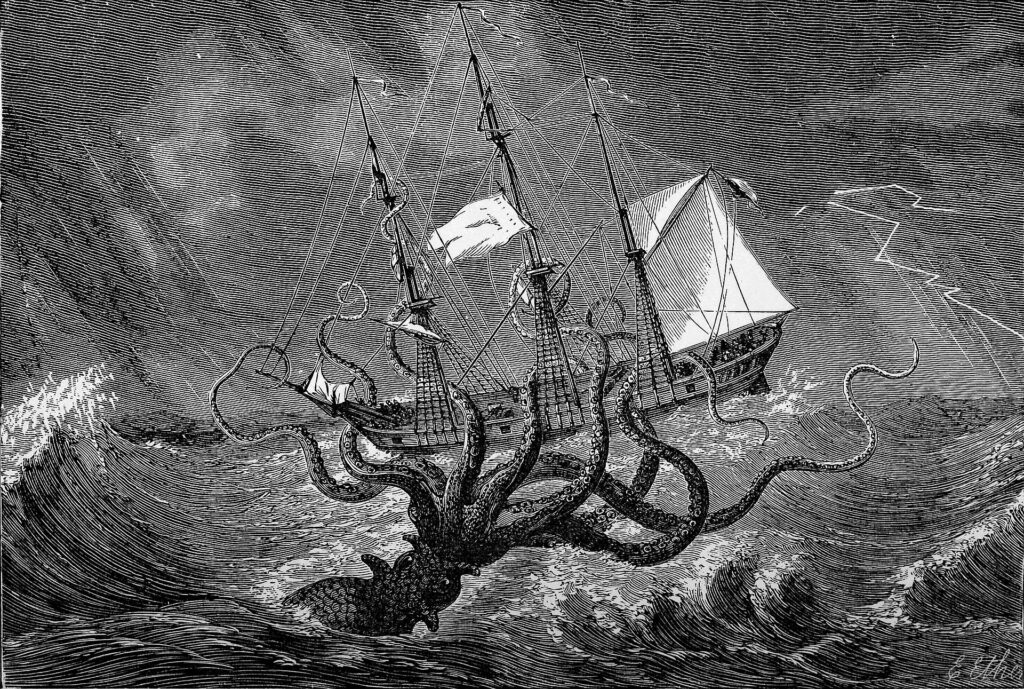
Originally based in Scandinavian folklore, the Kraken is a large mythological creature said to haunt open water. The first known account of the Kraken was written by King Sverre of Norway in 1180 during a time when the oceans were relatively uncharted. The Kraken was said to be a hunter of ships, the bigger the better, making it a predator feared by anyone who sailed out to sea. Because of the creature’s rare appearance, no one knew exactly what they were dealing with or what type of creature the Kraken might be. All they knew was it was massive, had eight legs, and showed absolutely no fear of humans. In fact, humans seemed to be among the Kraken’s favourite snacks. And if the creature wasn’t able to take down the ship with its own legs, it would swim around the vessel fast enough to create a maelstrom, dragging the ship to the bottom of the ocean.
Today, we know that the Kraken is nothing but a legend. But with the prevalence of stories and claims from countries around the world, surely there was something in the water that was freaking people out. Was it really a giant man eating monster, or was it a sea creature that has only recently been identified?
The Real Kraken?

Like many mythological creatures, the story of the Kraken would have stemmed from sightings of a real animal. In this case, it’s believed that a likely candidate behind the Kraken/sea monster stories is the elusive giant squid. First photographed in the wild in 2004, the giant squid (or Architeuthis) can grow up to 13 metres in length and weigh as much as 900kg but typically average under 455kg. Their habitat is widespread and giant squids can be found along continental and island slopes all over the world. A solitary creature, the exact depth of their ideal habitat isn’t known, but it’s believed to be between 300-1000 metres under the ocean’s surface. Because of this, it’s very rare for a human to come across a giant squid unless its sick or dying. This is why most images you’ll find of the giant squid online are of carcasses. Newfoundland, Norway, and the British Isles are located among particularly deep parts of the ocean and therefore see the most giant squid specimens unintentionally caught by fishermen.
Like other squid, the giant squid has eight arms and a pair of longer tentacles to assist with feeding. The mantle or the ‘head’ is shaped like a spade and includes two fins to assist with movement. Unlike the colossal squid which has two eyes on the front of its head, giant squid have one eye in the front and one in the back, allowing it to keep a look out for its next meal and any dangerous predators, mainly the sperm whale. Their eyes are among the largest in the animal kingdom measuring (a horrifying) 10 inches in diameter. For reference, the dinner plate you’ll be eating off of tonight is about the same size. Giant squids also have a beak, like other squid, and suckers surrounded by a ring of razors.
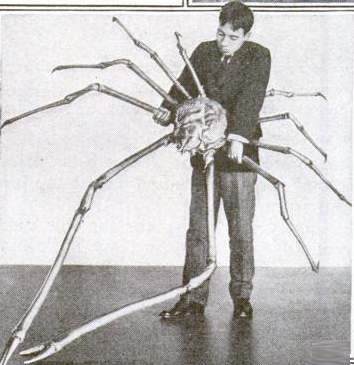
The reason sea creatures can grow to such massive sizes is due to a phenomenon called deep-sea gigantism. Reasons behind deep-sea gigantism range from lower temperatures, food scarcity and the need to go longer without a meal, reduced predation pressure, and increased dissolved oxygen. These animals live in the generally inaccessible abyssal zone of the ocean between 4,000 to 6000 meters deep. This explains how some marine creatures, including squids, increase in size the further below sea level the live. Other animals that experience deep-sea gigantism are Japanese spider crab (up to 3.7 meters in length), deepwater stingray (up to 2.7 meters in length and 1.5 meters in width), big red jellyfish (up to 30 inches in diameter), and giant oarfish (up to 8 meters in length). The zone, which is in complete darkness, makes up 83% of the ocean and 60% of the surface of our planet. Kind of makes you wonder what else is down there, doesn’t it?
Unfortunately, because of their deep sea habitat, scientists don’t know nearly as much about giant squids as they wish they did. The same can be said for the study of deep-sea gigantism in general, the habitats of these animals are so far below the surface that study is incredibly difficult. Between inaccessibility, terrifying photographs, and incredibly scarce sightings, the mysterious nature of the giant squid is as unsettling as the Kraken of legend. The less we (the laymen) know about giant squids, the more our brains fill in the blanks. But are they really the human-hunting, ship-sinking monsters as portrayed in myth?
Are Giant Squid a Threat to Humans?
Did sailors of yore have a legitimate reason to fear the ‘Kraken’? Has the legend tainted the reputation of giant squids in the same way Jaws made us unfairly villainise sharks? The diet of the giant squid typically consists of fish and other squid (yes, our many-legged friends are cannibals) — but not humans, however that doesn’t mean one wouldn’t hunt you if you happened into it’s Deepwater territory. And the way they would go about killing you is not a way you’d want to go. Giant squid hunt from below, so the chances of seeing it come at you in the first place is slim to none. So you don’t have to worry about out swimming it, you probably won’t realise it’s coming at you until it’s far too late. You’ll then be dragged down, down, down into the darkness of the ocean so the giant squid can privately enjoy his meal without the risk of getting attacked by another predator, specifically his biggest enemy the sperm whale.
At this point, your eardrums have probably burst from the pressure change and your bones are likely broken from being squeezed by tentacles. The giant squid will now begin his feast, ripping you apart with his beak and slicing you into even smaller pieces with his radula – which is basically a tongue covered in sharp teeth.
So why aren’t humans terrified to go in the ocean? Why don’t beaches have giant squid warnings? Why was Jaws a shark and not a giant squid (I guess the film would be called ‘Beak’, which is less intimidating)? The comforting reality is that giant squid live so far below the surface that it’s rare for a human to ever come across one. The chances of you happening upon a giant squid during your holiday in Cornwall is pretty much slim to none. However, some scientists believe sightings of giant squid will become more frequent as water temperatures rise due to climate change. So while attack from a giant squid isn’t something you need to worry about now, there’s a chance it could become a small issue in the distant future.
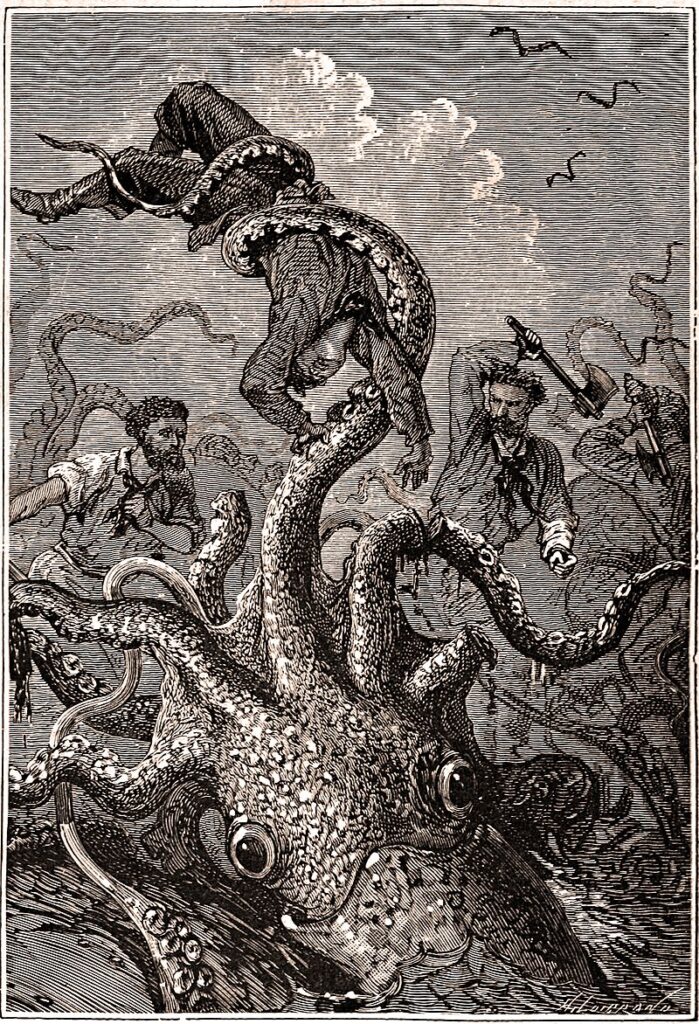
Are Giant Squids a Threat to Boats?
But what about boats, or submarines a la Jules Verne’s Twenty Thousand Leagues Under the Sea? There is currently no record of a squid of any kind successfully taking down a water vessel, but that doesn’t mean they haven’t given it the ol’college try. Here are a few notable examples:
The first recorded ‘attack’ on a sea vessel by a giant squid occurred in November 1861 on the French Navy corvette Alecton. While under the command of Captain Frédéric Bouyer, the Alecton was sailing near Tenerife on her way to Cayenne when a ‘gigantic’ squid was spotted in nearby water. During that time, the existence of giant squid was up for debate, so the captain ordered the crew to capture the creature. In this case, the squid didn’t have a chance to attack the ship before the crew opened fire. Unaffected by bullets, the men attempted to lasso a rope around the squid’s body, but the creature’s weight was too great to haul aboard. A piece of the squid tore off in the chaos and was sent to a museum to be studied. It was confirmed to be a sample from a giant squid by American invertebrate zoologist A. E. Verrill. This encounter inspired Jules Verne when he wrote Twenty Thousand Leagues Under the Sea, which was published nine years later in 1870.
During the 1930s, the Royal Norwegian navy’s tanker the Brunswick dealt with three separate attacks from aggressive giant squid. Since the ship was 15,000 tons, the squid were unable to harm the ship despite great efforts. The sailors were left unharmed, but the squid were killed by the ship’s propellers. Despite these attacks, it isn’t clear why the squid saw the Brunswick as a necessary target, but some scientists hypothesis that squid simply mistake boats as a predator and go on the defense.
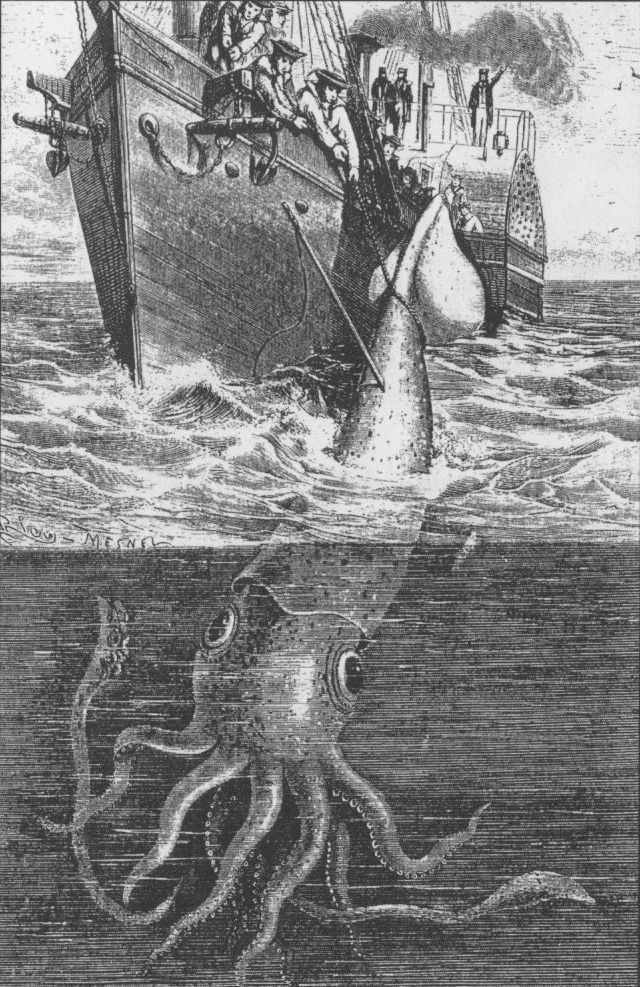
The most ironic instance of a giant squid attacking a boat occured in 2003 during the Jules Verne Trophy race around the world. A competing yacht captained by Olivier de Kersauson was attacked a few hours after leaving Brittany, France. According to Kersauson he “saw a tentacle through a porthole… It was thicker than [his] leg and it was really pulling the boat hard.” The giant squid had latched onto the hull of the yacht and only let go when Kersauson brought the vessel to a halt and the squid presumably grew bored and left.
More recently in 2017 (and on a much smaller scale), a video of a young giant squid hitching a ride with a South African paddleboarder went viral. The video showed James Taylor with the giant squid’s many legs hooked around the paddleboard in what some viewers believed to be a friendly greeting from the sea creature. However, the full video showed that the giant squid was actually incredibly unwell and wasn’t playing or attacking the paddleboard. The real story was that Taylor recognised the squid was dying and was attempting to drag it to shore in order to preserve the body for research purposes.
There are numerous other tales of giant squids attacking watercraft, however none of them come close to the intensity of legendary Kraken encounters. While giant squid do occasionally ‘attack’ boats, it’s most likely a case of mistaken identity and not the giant squid hunting for a tasty metal snack. Regardless, it’s no wonder a legend grew out of giant squid sightings. Squid are genuinely terrifying — the numerous legs and teethy suckers, the oddly shaped head and giant eyes… if anyone hundreds of years ago experienced that attacking their boat, of course they’re going to think it’s a sea monster.

The Kraken in Popular Culture
Humans love a good monster, and the Kraken has proven to be a particular favourite of authors and filmmakers throughout the years. In 1830 Alfred Tennyson wrote his poem The Kraken (1830), later influencing H.P. Lovecraft’s The Call of Cthulhu which documents the awakening of a gigantic creature sleeping for an eternity on the ocean floor.
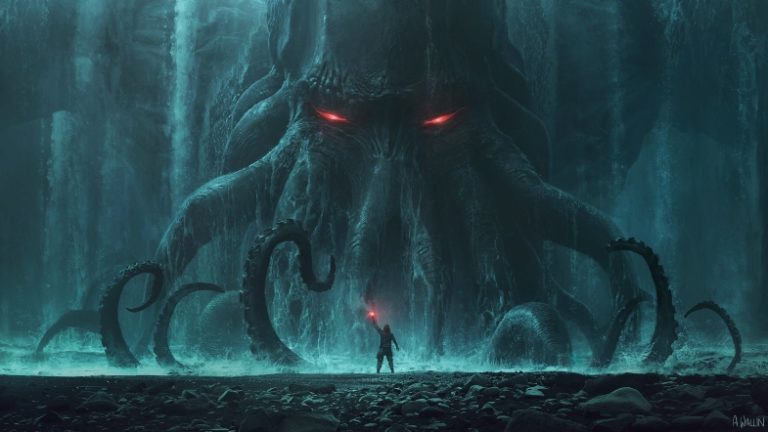
The Kraken also makes an appearance in Herman Melville’s Moby Dick (1851) and Victor Hugo’s Toilers of the Sea (1866). And fans of J.R.R. Tolkien’s Lord of the Rings will recall the Watcher in the Water guarding the gate to Moria, which bears a striking resemblance to the Kraken of legend. More recent examples include Michael Crichton’s novel Pirate Latitudes (2009), the sigil of House Greyjoy in George R. R. Martin’s A Song of Ice and Fire, and peaceful Krakens in Artemis Fowl: The Time Paradox by Eoin Colfer (2008).
Dungeons and Dragons, Magic: The Gathering, and World of Warcraft are among the dozens of role playing games that feature a Kraken. There’s even a rollercoaster in SeaWorld Orlando named after the mythological creature. And who could forget this memorable scene in Pirates of the Caribbean: Dead Man’s Chest (2006)?
We’re a Kraken obsessed world, and who could blame us? The fact that our eight-legged antagonist exists in some form in the real world makes it all the more fascinating. Who knows what lurks in the deepest, darkest corners of our oceans. Like Cthulhu, the Kraken could be enjoying it’s slumber and will soon awaken to reek havoc upon ships once again.
Read more about cryptids and Lovecraft on Curious Archive!
Sources and Additional Reading
BBC News – Giant squid ‘attacks French boat’ (2003)
Earth Touch – Here’s the full story behind that ‘friendly giant squid’ video (2017)
How Stuff Works – Could a squid take down a submarine?
Insider – Why giant squid, the once mythical kraken of the deep, are still mystifying scientists 150 years after they were discovered (2019)
Kubodero, Tsunemi and Kyoichi Mori. “First-ever observations of a live giant squid in the wild.” Proceedings. Biological sciences. 2005 Dec 22; 272(1581): 2583–2586.
Live Science – What is a Kraken? (2010)
National Geographic – The Global Kraken (2013)
Natural History Museum – Sea monsters and their inspiration: serpents, mermaids, the kraken and more
Salvador, Rodrigo B. and Barbara M. Tomotani. “The Kraken: when myth encounters science.” História, Ciências, Saúde – Manguinhos, Rio de Janeiro, v.21, n.3, jul.-set. 2014, p.971-994.
Science Focus – Everything you wanted to know about the giant squid (2022)
Smithsonian – Giant Squid
The Conversation – The real-life origins of the legendary Kraken (2015)
The Verge – A brief history of squid video (2016)
What If – What if you were attacked by a giant squid?
Wikipedia – Kraken / Giant Squid / List of giant squid specimens and sightings / Cephalopod attack / Deep-sea gigantism / Abyssal zone / French corvette Alecton / Kraken in popular culture
ZME Science – Why some creatures in the deep sea grow to enormous sizes (2021)
